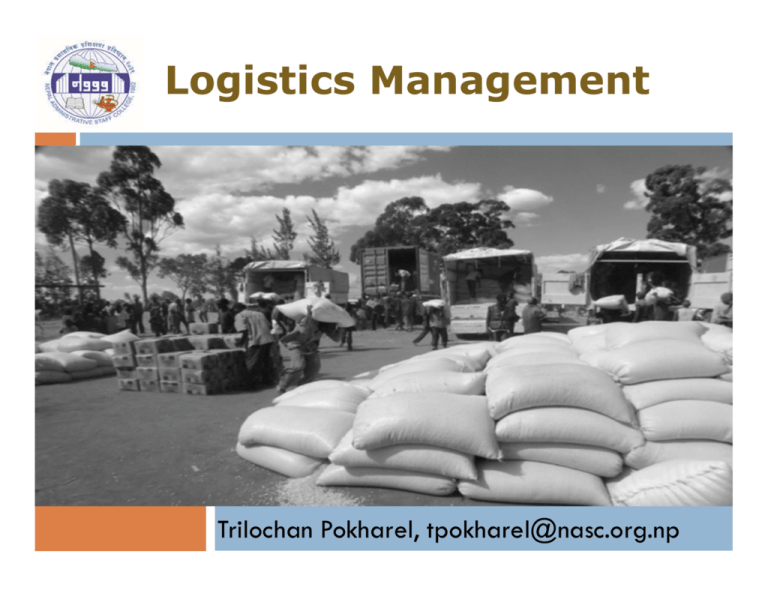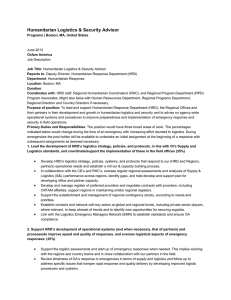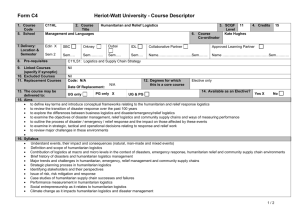Logistics Management
advertisement

Logistics Management Trilochan Pokharel, tpokharel@nasc.org.np Session Outline Logistic management in disaster Elements and process of logistic management Logistic planning Scope of logistic management A Recognised Leader in Logistics Logistic Supply Chain Elements Planning Efficiency Sourcing Effectiveness Logistics Information Humanitarian Supply Chain Your Supply Chain Will Depend On: Operational Context External Environmental Factors Internal Operational Requirements Humanitarian Cargo Supply, Transport & Storage Markets Logistics Suppliers / Port of Origin International Transport Central Warehouse National Transport Local Warehouse Local Transport Commercial: Consumption/sale to customer Humanitarian: Service/distribution to beneficiaries Documentation throughout the Supply Chain Logistics Upstream Downstream Upstream Network Downstream Network Upstream Planning – Nepal Example Infrastructure – Example The Programmes Delivery Type Service Delivery Direct Delivery Delivery Frequency Pipeline One Off Need-to-Delivery Time V O L U M E Food Other than Food 72hrs 2 wks 3-4wks 8wks Prioritization SelfActual- Maslow’s Pyramid isation Pursue Talent, Creativity, Fulfillment Self-Esteem Achievement, Mastery Recognition Generic Emergency Prioritisation Food (Weeks) Water Belonging Friends, Family, Community (Days) Heat (Hours) Safety Security, Shelter Air (Minutes) Physiological Food, Water, Warmth Hierarchy of physiological needs Humanitarian Cargo Relief Items Medical Items Housing & Shelter Items WASH Items Dangerous Items Operational Food Support commodities Equipment Food Commodities Cereals/ Cereal Blends Oils Salt Sugar Pulses (legumes) Fortified Foods RTUF Need-to-Delivery Time Needs Assessment Beneficiary Request Made Request Processed Information Time Beneficiary & Movement Time Goods Moved Supply Push & Pull First few days – Needs not clearly defined Push Pull First few weeks – Needs defined Humanitarian Staging Area Push-Pull Boundary Push Strategy Raw Materials Normal Conditions Pull Strategy End Customer Staging Area Emergency Conditions Simchi-Levi et al. 2008: 190 Push-Pull LONG Pull Prepare SHORT Response Time Managing the Flow Call Forward Push LOW HIGH Level of Uncertainty Prioritization V O L U M E Food Other than Food Shift from air to surface Shift from kits to single/customized items 72hrs 2 wks. 3-4wks 8wks Preparedness: The Five Pillars The 5 Pillars Coordination/ Partnerships People Stocks Standards/ Systems Logistics Information Preparedness: Example What logistics activities would you do the prepare for this specific situation? Magnitude 8+ earthquake affecting the Kathmandu Valley Potential Fatalities: 100,000 people Potential Injuries: 300,000 people Potential Displaced / Affected: 1,800,000 people Elements of a Preparedness Plan Preparation Hazard & Risk Identification and Analysis Identification & Analysis Contingency Planning Process Scenario and Planning Assumptions Objectives and Strategies Response Planning Management & Coordination Arrangements Sectorial Response Plans Implementing Preparedness Preparedness Actions Elements of a Contingency Plan Logistics Contingency Planning Stockpiles Procurement Systems Quality Control Process Warehousing Facilities Registration, Distribution & Monitoring Processes Logistics Mechanisms (Transport & Distribution) Airports & Seaports Infrastructure Transport Agreements Staffing Capacity Logistics Capacity Assessments Review Disaster Identification Entry Points Disseminate Resource Capacity Transport Infrastructure Elements and Scope of an Assessment # affected people Warehouses Distribution Plans Coordination Capacity Materials Required Electric Power Communications Transfer Points Water / Sewage Airports / Aircrafts Local Truck Capacity Seaport s Roads & Bridges Railroads Questions











